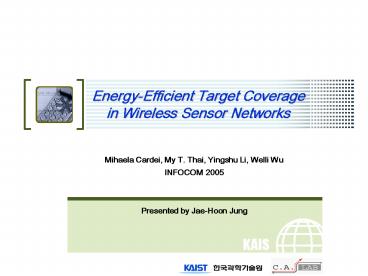EnergyEfficient Target Coverage in Wireless Sensor Networks - PowerPoint PPT Presentation
1 / 22
Title:
EnergyEfficient Target Coverage in Wireless Sensor Networks
Description:
in Wireless Sensor Networks. Mihaela Cardei, My T. Thai, Yingshu Li, Welli Wu. INFOCOM 2005 ... Target Coverage in Wireless Sensor Networks. Introduction (1/2) ... – PowerPoint PPT presentation
Number of Views:128
Avg rating:3.0/5.0
Title: EnergyEfficient Target Coverage in Wireless Sensor Networks
1
Energy-Efficient Target Coverage in Wireless
Sensor Networks
- Mihaela Cardei, My T. Thai, Yingshu Li, Welli Wu
- INFOCOM 2005
- Presented by Jae-Hoon Jung
2
Contents
- Introduction
- Target coverage problem
- Related work
- Maximum set covers problem
- Problem formulation
- Two heuristics
- LP-MSC heuristic
- Greedy-MSC heuristic
- Simulation results
- Conclusion
3
Introduction (1/2)
- Power-constrained wireless sensor networks
- Prolonging network lifetime through power saving
technique - Sensor scheduling
- Active mode vs. sleep mode
- Coverage problem
- Given
- Field
- N sensor nodes
- Question
- How well can the field be monitored?
- Maximizing network lifetime by sensor scheduling
4
Introduction (2/2)
- Area coverage problem
- Sensing overall area
- Minimizing active nodes
- Maximizing network lifetime
- Target coverage problem
- Sensing all targets
- Minimizing active nodes
- Maximizing network lifetime
5
Related Work (1/2)
- Disjoint Set Covers
- Divide sensor nodes into disjoint sets
- Each set completely monitor all targets
- One set is active each time until ran out of
energy - Goal To find the maximum number of disjoint sets
- This is NP-Complete
Disjoint set cover Same time interval
Non-disjoint set cover Different time interval
6
Related Work (2/2)
C s1, s2, s3, s4 R r1, r2, r3 Sensors
lifetime 1
Our Approach S1 s1, s2 with t1 .5
S2 s2, s3 with t2 .5 S3 s1, s3 with t3
.5 S4 s4 with t4 1 Lifetime G
2.5
Disjoint sets S1 s1, s2 S2 s3,
s4 Lifetime G 2
7
Maximum Set Covers (MSC) Problem
- Given
- C set of sensors
- R set of targets
- Goal
- Determine a number of set covers S1, , Sp and
t1,, tp - where
- Si completely covers R
- Maximize t1 tp
- Each sensor is not active more than 1
- MSC is NP-Complete
8
Problem Formulation (1/3)
- Using Linear Programming Approach
- Given
- A set of n sensor nodes C s1, s2, , sn
- A set of m targets Rr1, r2, , rm
- The relationship between sensors and targets
- Ck isensor si covers target rk
- s1 r1 C s1, s2, s3
- s2 r2 R r1, r2, r3
- s3 r3 C1 1,3 C2 1,2 C3 2,3
- Variables
- xij 1 if si ? Sj, otherwise xij 0
- tj ?0, 1, represents the time allocated for Sj
9
Problem Formulation (2/3)
maximize network lifetime
sensors lifetime constraint
all targets must be covered
10
Problem Formulation (3/3)
0 yij tj 1
11
LP-MSC Heuristic
- Initial G 0
- Let be the optimal solution of the LP
formulated before - First approximation can be obtained as follows
- Set
- For each k, choose an
- Update the network lifetime
- Update the remaining lifetime for each sensor
12
LP-MSC Heuristic
- Iteratively repeat step 1 and 2 by solving this
- Return G if there is no longer any set that can
cover all targets
13
Greedy-MSC Heuristic
- Select critical target
- Target most sparsely covered
- Select sensor
- Covers critical target
- Covers a large number of uncovered targets
14
Simulation environment
- Stationary sensor and target
- Randomly located in 500m 500m
- Number of sensor nodes
- 25 750
- Number of targets
- 5 15
- Sensing range
- 100m 300m
- Solving linear programming
- Using optimization toolbox in Matlab
15
Simulation results
- Network lifetime with number of sensors with
range r 250m
16
Simulation results
- LP-MSC heuristic, network lifetime with number of
sensors for 10 targets
17
Simulation results
- Greedy-MSC, network lifetime for 5 targets and
range r 250m
18
Conclusion
- Contributions
- Proposing maximum set covers approach
- Proving its NP-completeness
- Proposing an efficient heuristic
- Using a LP formulation
- Using greedy approach
- Future work
- k-coverage
- p-coverage
19
NP-completeness of MSC
- Theorem MSC is NP-Complete
- Proof
- First, define the Decision Version of MSC
problem. - To show that MSC ? NP
- Given a family of set covers S1, , Sp with time
weights t1, , tp, and the number k. - Then we can verify in polynomial time whether the
set covers meet the requirements - To prove the decision version of MSC is NP-hard
- Reduce 3-SAT problem to it in polynomial time
Given a collection C of subsets of a finite set
R, and a number k, find a family of set covers
S1,..., Sp with time weights t1,..., tp in 0, 1
such that t1 tp k and for each subset s
in C, s appears in S1, , Sp with a total weight
of at most 1, where 1 is the lifetime of each
sensor.
20
LP-MSC Heuristic
- Runtime complexity
21
Greedy-MSC Heuristic
- Select critical target
- Target most sparsely covered
- Select sensor
- Covers critical target
- Covers a large number of uncovered targets
- Runtime complexity
- O(dm2n)
- d the number of sensors that covers
most sparsely covered target
22
Simulation results
- Runtime of LP-MSC and Greedy-MSC heuristics































